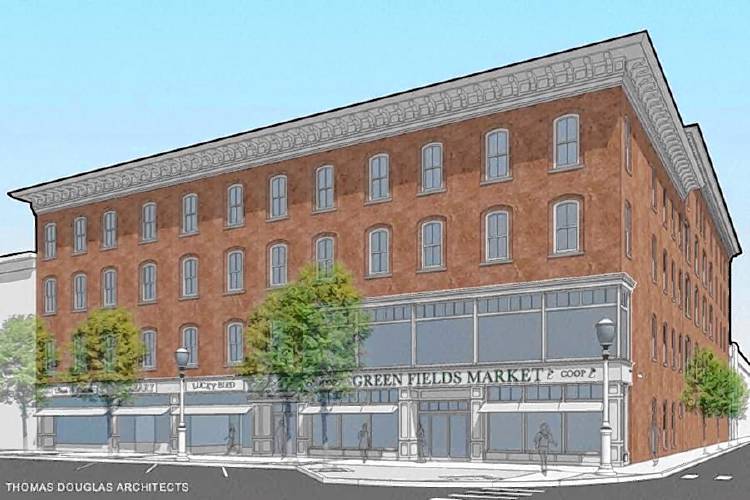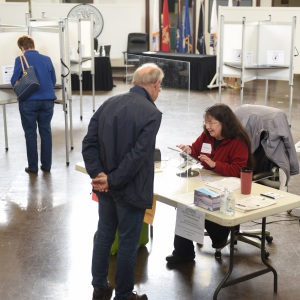My Turn: Greenfield’s record on housing strong, but more work to do

A design image of the planned redevelopment project at the former Wilson’s Department Store, which involves relocating and expanding Green Fields Market into the first floor and turning the upper floors into 65 mixed-income rental apartments. THOMAS DOUGLAS ARCHITECTS
| Published: 03-26-2024 3:24 PM |
It’s hard to pick up a local or national newspaper that doesn’t have an article that is either about a housing issue or refers to a housing issue as a factor in the topic being discussed, whether it’s about a lack of affordable housing, or the need for sober housing, or a community’s reluctance to accept a new housing development, or another community’s genuine efforts to solve this vexing problem.
The housing supply and affordability crisis isn’t just a Greenfield problem; it exists throughout the state. It affects people across all demographics, from the very poorest among us who often must decide whether to buy groceries or pay rent to seniors who want to downsize but can’t find a smaller, more affordable home to young people wanting to live near where they work but who can’t afford to rent or buy in that community.
We can all agree that this crisis exists, but we can’t all agree on how to solve it. Like so many societal issues elected officials are expected to fix, increasing affordable housing is a multi-faceted, complicated, and expensive problem. Since taking office, Gov. Maura Healy has shown she will take all manner of creative approaches and administrative steps to ensure we increase affordable housing in Massachusetts. She’s set up a task force to create a unified state housing policy and another one to review and recommend changes to local zoning and building regulations that stifle increasing housing in many communities. She’s introduced a $4 billion housing plan, the Affordable Homes Act, designed to increase housing by creating 44,000 new homes using a combination of capital spending, tax credits, and policy changes and initiatives. Among the changes featured in the plan is a change that allows accessory dwelling units (ADUs) of less than 900 square feet to be built. Given her resolve to develop workable solutions to the problem, I have no doubt the governor will succeed on many fronts. And she will face political backlash from others regarding increasing affordable housing.
Coming to grips with this problem won’t be solved by a cookie-cutter solution. What’s good for one community or region in Massachusetts may not be good for another. The recent resounding NIMBY vote in the town of Milton against complying with the new zoning regulations required by the Charlie Baker-era MBTA Communities Act amplified that reality. The Act is a state-mandated plan requiring communities served by the T in and near Boston to create new zoning that allows the building of multifamily housing near T stops. The state lost no time in penalizing Milton’s refusal to obey the law. The town was recently notified that it would lose significant amounts of money in state grants. On Feb. 27, less than two weeks after the vote, Attorney General Andrea Campbell sued the town of Milton. In other words, the state means business. Other Massachusetts communities from the North Shore to eastern Massachusetts are ignoring the Milton fallout and refusing to create housing plans that include additional affordable housing. Closer to home, many residents of Leverett turned out at a recent meeting to oppose the creation of new housing on land formerly owned by Yankee Candle founder Michael Kittredge.
Given our long-standing commitment to creating affordable housing, those of us in Greenfield should be patting ourselves on our backs. For decades, our city has complied with the state’s Chapter 40B requirement that at least 10-15 percent of our year-round housing meet affordability guidelines. However, as housing and rental prices in Greenfield rise, we risk bumping up against non-compliance with 40B. Today, we are at 14.92 percent. So, there is some room for us to create more market-rate housing, which we also need. The plans for housing in the Wilson’s building, which I supported as mayor, and a different plan and location for additional downtown housing include market-rate housing.
A decade ago, through the efforts of the Greenfield Planning Board, which I chaired at the time, the city added accessory dwelling units of a maximum of 900 square feet to its zoning ordinance. Yes, we were 10 years ahead of the state! What the city faces today is a lack of land for new development, which means our options for creating new housing should be focused on the rehabilitation of existing housing, infill in our urban core, and the creation of accessible two and three-story housing. Given our track record, I do not doubt we will continue adding more housing. Our way.
Roxann Wedegartner lives in Greenfield and is the city’s former mayor.
Article continues after...

 The World Keeps Turning: Quantifying happiness — How we measure up
The World Keeps Turning: Quantifying happiness — How we measure up  My Turn: Dear Patients — We hear you!
My Turn: Dear Patients — We hear you! Ava Gips: Carolyn Shores Ness gets things done
Ava Gips: Carolyn Shores Ness gets things done Annette Pfannebecker: Vote yes for Shores Ness and for Deerfield
Annette Pfannebecker: Vote yes for Shores Ness and for Deerfield
